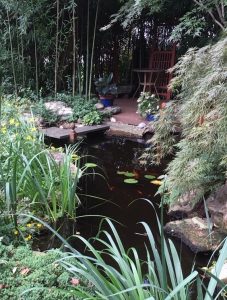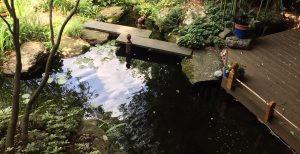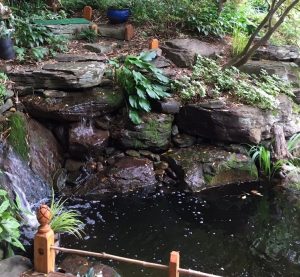Pond Water Quality – Water Balance and Sources
Part 1
By Albert V. Short, Fairfax Master Gardener Intern
Here’s are questions to ask yourself about your pond water:
My pond water is clear as glass, so can I assume it is safe for my fish? YES or NO
My pond water is green with algae. Will it hurt my fish? YES or NO
This article reviews the factors that contribute to good or bad water quality in your garden pond and will address water balance and water sources.
 Water balance is simply creating an aquatic environment that is conducive to fish and plant survival and good health. The ideal pH for a pond is in the range of 7.0 to 7.2. You can use a simple test kit (available in pet stores or on-line) to determine the water’s pH, and it can be adjusted up or down with chemical compounds, also locally available. This usually takes a few days and multiple applications of the adjustment compounds. The pH level should be checked periodically. This is the first step in establishing “water balance.”
Water balance is simply creating an aquatic environment that is conducive to fish and plant survival and good health. The ideal pH for a pond is in the range of 7.0 to 7.2. You can use a simple test kit (available in pet stores or on-line) to determine the water’s pH, and it can be adjusted up or down with chemical compounds, also locally available. This usually takes a few days and multiple applications of the adjustment compounds. The pH level should be checked periodically. This is the first step in establishing “water balance.”
Consider the source of the water for your pond. In this area it comes from a well, from county or city water supply or, in some cases, rainwater.
What are your concerns about the water source? Well water comes out of the ground at about 60 or 65 degrees F or maybe colder. Most importantly it’s been underground, perhaps for centuries, so it contains no oxygen. Oxygen (or more correctly Dissolved Oxygen or DO) is what keeps your fish alive. Well water unaerated will not support fish. It should be sprayed into the pond or run through a waterfall to aerate it.
 City or county water is treated to make it safe to drink. That’s great if you’re human, but it’s not great if you’re a fish trying to survive in tap water. The county puts chemical compounds in the water to sanitize it and keep it safe as it goes through its distribution system.
City or county water is treated to make it safe to drink. That’s great if you’re human, but it’s not great if you’re a fish trying to survive in tap water. The county puts chemical compounds in the water to sanitize it and keep it safe as it goes through its distribution system.
Here is a quote from the Fairfax Water Authority website that clearly defines what they do to the water to make it safe to drink but makes it deadly to fish and what can be done to make it “fish safe.”
“Do I need to treat the tap water in any way before I place fish in an aquarium?”
“Fairfax Water uses chlorine for disinfection purposes, which can be harmful to fish if not dechlorinated prior to placing fish in it. Fairfax Water utilizes two types of chlorine, free chlorine and chloramines (chlorine and ammonia mixture). Chloramines are normally used July — March, and free chlorine is generally used April — June. Free chlorine and chloramine dechlorination is performed differently. Chemical additives with directions for dechlorinating either free chlorine or chloramine from water for use in fish tanks or ponds are available at pet/fish supply stores.”
 Always assume that tap water contains chlorine, and you must test and dechlorinate the water. To test the water, purchase a chlorine test kit at a pet store or on-line. The goal is “zero,” that is no presence of chlorine or its variants in the water. To dechlorinate the water, use a dechlor liquid that treats both chlorine and chloramines; read the label before purchase. Add the dechlor liquid to your pond water, and it will instantly remove all the chlorine in the water.
Always assume that tap water contains chlorine, and you must test and dechlorinate the water. To test the water, purchase a chlorine test kit at a pet store or on-line. The goal is “zero,” that is no presence of chlorine or its variants in the water. To dechlorinate the water, use a dechlor liquid that treats both chlorine and chloramines; read the label before purchase. Add the dechlor liquid to your pond water, and it will instantly remove all the chlorine in the water.
In this area, rainwater can contain acid, and it should be checked with a pH test kit and adjusted as noted above.
Another aspect of “balance” is water temperature. Generally, well water is 60 or 65 degrees F, and County water can be in that range although it may be higher in the summer. There are two issues with water temperature. First is the oxygen level, and second is the impact of temperature variants on fish.
Fish survive by using the oxygen (more correctly dissolved oxygen or DO) in the pond water. As noted above, well water does not contain oxygen, and it can be aerated by spraying it in the pond or running it through a waterfall or some other device. County water is normally oxygenated. Pond oxygen levels vary directly with water temperature, and cold water suspends more DO than warm water. As water warms. its ability to suspend dissolved oxygen decreases to the point where at about 80 degrees F it plummets. That is why it is essential to have a waterfall or fountain on a garden pond. It is an attractive visible feature but also essential to maintain DO levels. DO levels are also influenced by atmospheric pressure and at low-pressure, oxygen levels drop. This is especially true when there is a rapid and significant drop in air pressure associated with a thunderstorm. This is not usually a problem unless the pond is overloaded with fish, there is a lack of aeration or the power goes out. The result can be a massive fish kill.
If you move fish from one container to another or from a pet store to your pond and there’s more than a 5-degree F difference in water temperature, you’re likely to kill them. Think of it like “transplant shock.” Small fish are most susceptible. If you are entering fish into your pond, put them in a plastic bag with water from the old container. Place that plastic bag in the pond and let it slowly (for an hour or two) moderate its temperature so it is the same as the pond water. Then open the plastic bag and release the fish into the pond.
To this point, we have reviewed how to treat your pond water to make it safe for fish, and the impact of temperature on fish. Next month we will explore some typical pond problem areas and solutions.
References
Frequently Asked Questions, Customer Service, Fairfax Water